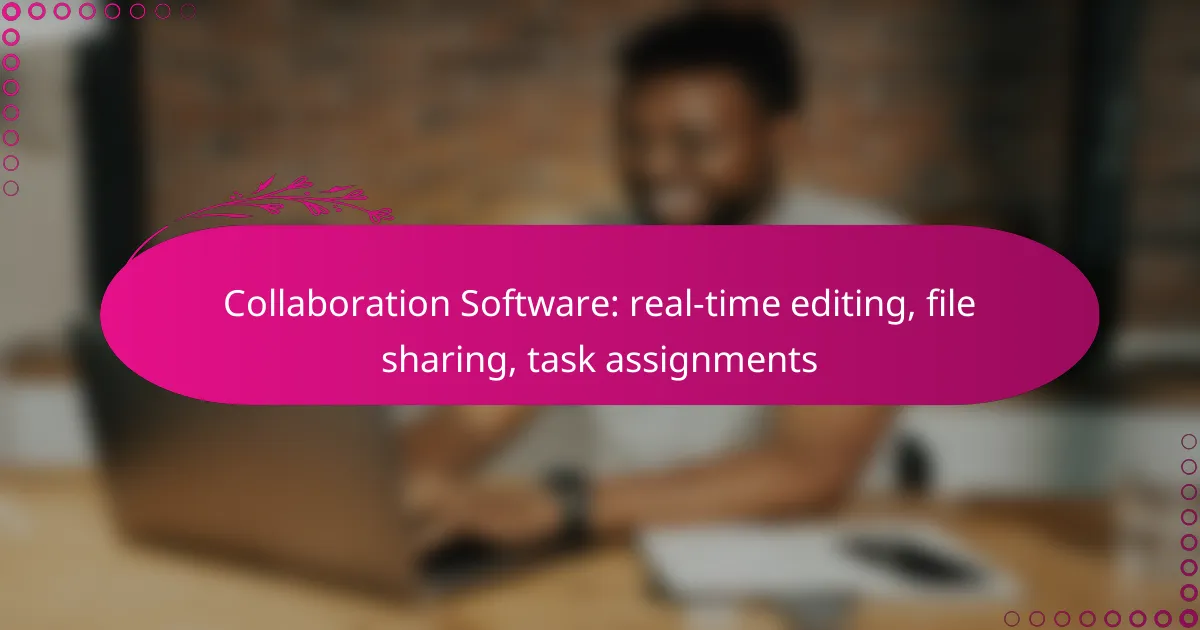Collaboration software has transformed the way teams work together, offering essential features such as real-time editing, file sharing, and task assignments. Tools like Google Workspace and Microsoft 365 facilitate seamless communication and collaboration, allowing users to upload and access files effortlessly while managing tasks effectively. By integrating these functionalities, teams can enhance productivity and ensure projects are completed on time.

What are the best collaboration software options for real-time editing in Canada?
In Canada, several collaboration software options excel in real-time editing, file sharing, and task assignments. Key choices include Google Workspace, Microsoft 365, Notion, Quip, and Zoho WorkDrive, each offering unique features tailored to enhance team productivity.
Google Workspace
Google Workspace is a comprehensive suite that includes tools like Google Docs, Sheets, and Slides, allowing multiple users to edit documents simultaneously. Its real-time collaboration features are intuitive, making it easy for teams to communicate and make changes instantly.
Consider using Google Workspace if your team values seamless integration with other Google services and requires robust sharing options. The platform supports various file formats and offers generous storage, which is beneficial for teams managing large projects.
Microsoft 365
Microsoft 365 combines familiar applications like Word, Excel, and PowerPoint with cloud capabilities for real-time collaboration. Users can co-author documents, track changes, and utilize built-in chat features to streamline communication.
This option is ideal for teams already using Microsoft products or those needing advanced formatting and data analysis tools. Be mindful of licensing costs, as Microsoft 365 operates on a subscription model that varies based on the number of users and features selected.
Notion
Notion is a versatile tool that combines note-taking, task management, and database functionalities. Its real-time editing capabilities allow teams to collaborate on documents, create project boards, and manage tasks all in one place.
Notion is particularly useful for teams looking for a customizable workspace. However, it may require some time to set up and adapt to its unique interface, so consider investing time in training for optimal use.
Quip
Quip focuses on combining documents and spreadsheets with chat features, making it easy for teams to collaborate in real-time. Users can create and edit documents while discussing changes within the same interface.
This software is beneficial for teams that prioritize communication alongside document editing. However, Quip may not be as feature-rich as some competitors, so assess your team’s specific needs before committing.
Zoho WorkDrive
Zoho WorkDrive offers a collaborative platform that includes document editing, file sharing, and task management. It supports real-time collaboration and integrates well with other Zoho applications, making it a solid choice for teams already using the Zoho ecosystem.
Consider Zoho WorkDrive if your team requires a cost-effective solution with strong privacy features. The platform provides various pricing tiers, making it accessible for small to medium-sized businesses in Canada.

How does file sharing work in collaboration software?
File sharing in collaboration software allows users to upload, access, and distribute files in real-time, enhancing teamwork and productivity. This process typically involves cloud storage, enabling seamless access from various devices and locations.
Cloud storage integration
Cloud storage integration is a key feature of collaboration software, allowing users to store files online and access them from anywhere. Popular services like Google Drive, Dropbox, and OneDrive are commonly used, providing ample space and easy sharing options.
When selecting a collaboration tool, consider the storage limits and compatibility with existing cloud services. Many platforms offer free tiers with limited storage, while paid plans provide additional space and features.
Version control features
Version control features help track changes made to files, ensuring that users can revert to previous versions if needed. This is crucial in collaborative environments where multiple users may edit the same document simultaneously.
Look for software that automatically saves versions and allows users to view or restore earlier iterations. This reduces the risk of losing important information and helps maintain a clear project history.
Access permissions
Access permissions control who can view or edit files within collaboration software. This feature is essential for maintaining security and ensuring that sensitive information is only accessible to authorized users.
When setting up access permissions, consider using roles such as viewer, editor, or admin to manage user capabilities effectively. Regularly review permissions to ensure they align with current project needs and team changes.

What are the task assignment features in collaboration tools?
Task assignment features in collaboration tools enable teams to allocate responsibilities, monitor progress, and ensure timely completion of projects. These features typically include task tracking, deadline setting, and team notifications, all designed to enhance productivity and accountability.
Task tracking
Task tracking allows team members to monitor the status of assigned tasks in real time. This feature often includes visual indicators, such as progress bars or checklists, to show completion levels. Effective task tracking helps identify bottlenecks and ensures that everyone is aware of their responsibilities.
Many collaboration tools offer filtering options to view tasks by assignee, project, or status, making it easier to manage workloads. For instance, using a Kanban board can visually represent tasks in different stages, facilitating better workflow management.
Deadline setting
Deadline setting is crucial for maintaining project timelines and ensuring accountability among team members. Collaboration tools typically allow users to assign specific due dates to tasks, which can be adjusted as needed. Clear deadlines help prioritize work and keep the team focused on critical deliverables.
When setting deadlines, consider using reminders and alerts to notify team members of upcoming due dates. This proactive approach can significantly reduce the risk of missed deadlines and help maintain project momentum.
Team notifications
Team notifications keep everyone informed about task updates, changes, and deadlines. Collaboration tools often provide customizable notification settings, allowing users to choose how and when they receive alerts. This feature ensures that team members stay engaged and aware of their responsibilities.
Effective use of notifications can enhance communication and reduce misunderstandings. However, be mindful of notification overload; encourage team members to adjust their settings to receive only the most relevant updates, thus maintaining focus on their tasks.

What are the pricing models for collaboration software in Canada?
Collaboration software in Canada typically offers various pricing models, including subscription plans, free trials, and enterprise pricing. These models cater to different user needs and organizational sizes, allowing businesses to choose the most suitable option for their requirements.
Subscription plans
Subscription plans are the most common pricing model for collaboration software. They usually operate on a monthly or annual basis, with costs varying based on features and the number of users. For instance, basic plans may start around CAD 10 to CAD 20 per user per month, while more comprehensive packages can exceed CAD 50 per user per month.
When selecting a subscription plan, consider the specific features your team needs, such as real-time editing, file sharing, and task assignments. Some providers offer tiered plans that unlock additional functionalities as you move up the pricing ladder.
Free trials
Many collaboration software providers offer free trials, allowing users to test the software before committing to a subscription. These trials typically last from 7 to 30 days and provide access to most features. This is a great way to evaluate the software’s usability and how well it fits your team’s workflow.
Be mindful of the trial’s limitations, such as user caps or restricted features. Make sure to gather feedback from your team during the trial period to assess whether the software meets your collaboration needs.
Enterprise pricing
Enterprise pricing is designed for larger organizations that require customized solutions and advanced features. This model often involves negotiations with the provider to determine pricing based on the number of users, specific needs, and additional services like dedicated support or training.
Enterprise plans can vary significantly in cost, often starting from several thousand CAD per year. It’s essential to conduct a thorough assessment of your organization’s requirements and compare offerings from different vendors to ensure you get the best value for your investment.

What criteria should you consider when choosing collaboration software?
When selecting collaboration software, prioritize user interface, integration capabilities, and real-time functionalities. These factors significantly impact user experience and overall productivity.
User interface
A user-friendly interface is essential for effective collaboration software. It should be intuitive, allowing team members to navigate easily without extensive training. Look for features like drag-and-drop functionality and customizable dashboards to enhance usability.
Consider the design aesthetics as well; a clean and organized layout can improve engagement and reduce frustration. Test the software with a small group to gather feedback on usability before making a final decision.
Integration capabilities
Integration capabilities determine how well the collaboration software works with other tools your team uses. Ensure the software can connect seamlessly with project management, communication, and file storage applications to streamline workflows.
Check for compatibility with popular platforms like Google Workspace, Microsoft 365, or Slack. A software that supports API access can also provide flexibility for custom integrations, which is beneficial for larger organizations with specific needs.
